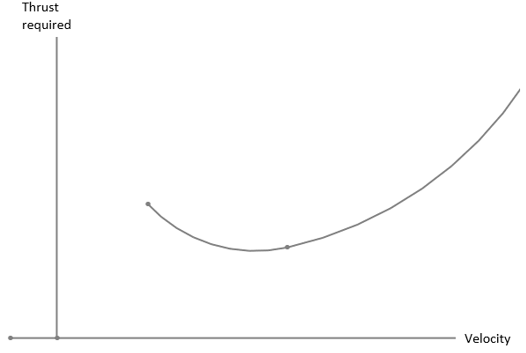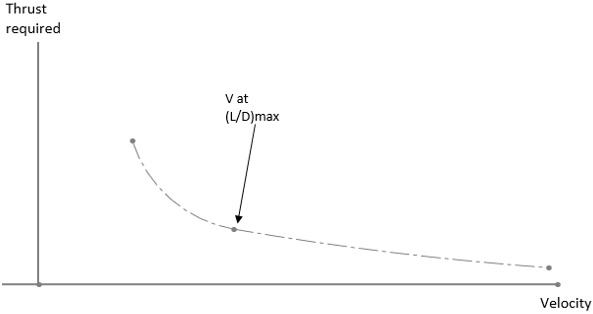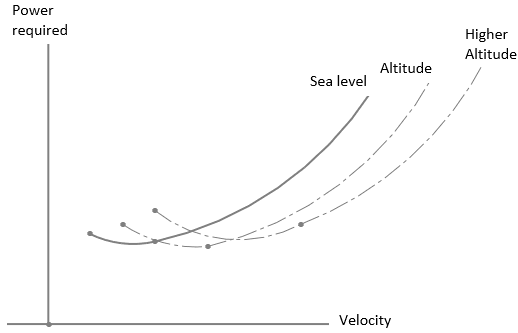This set of Aircraft Design Questions and Answers for Campus interviews focuses on “Flight Mechanics – Steady Level Flight-2”.
1. Following diagram represents ____________

a) thrust required curve
b) lift curve
c) drag polar
d) lift polar
View Answer
Explanation: Above diagram is showing a typical Thrust required curve. Variation of Thrust required can be observed in the diagram. Lift curve is showing the relationship between lift and angle of attack. Drag polar is showing the graphical representation of the aircraft drag characteristics.
2. Following diagram represents _________

a) lift induced thrust required
b) zero lift thrust required
c) drag polar
d) lift curve
View Answer
Explanation: Para below it Lift induced thrust required is shown in the diagram. Lift induced thrust required and zero lift thrust required are not equal, they are two different properties. Lift curve and drag polar is used to provide information of the lift variation and drag variation respectively.
3. Calculate how much power will require to maintain cruise speed of 120 m/s if thrust required is 1KN. Consider steady level flight.
a) 120KW
b) 110N
c) 120N
d) 129W
View Answer
Explanation: Power = thrust*velocity = 120*1 = 120KNm/s = 120KW.
4. An aircraft has L/D as 12 and thrust required at this value is 100N. Now if L/D has doubled then what will be the new thrust required?
a) 50N
b) 500N
c) 100 N
d) 12.5N
View Answer
Explanation: Given, 1: L/D = 12 and thrust required T1 = 100N
Now, L/D is doubled. Hence, new thrust required T2 = T1*(old L/D) / (New L/D)
= 100*12/2*12 = 100*12/24 = 50N.
5. An aircraft is operating with CL of 1.5 and has power required of 120W. If we want to reduce the power required by half then, find the value of CL at this power required condition. Consider steady level flight.
a) 2.38
b) 1.946
c) 9.45
d) 5.59
View Answer
Explanation: Given, P1 = 120W, CL1 = 1.5, P2 = P1/2 = 120/2 = 60W.
Now, CL for new Power required P2 is given by,
CL2 = CL1*[P1/P2](2/3)
= 1.5*[120/60](2/3) = 2.38.
6. Following diagram represents ________

a) altitude effect on power required
b) altitude effect on thrust
c) drag polar
d) lift curve
View Answer
Explanation: Above diagram is showing a typical power required graph. Above diagram is showing the altitude effects on the power required. Altitude effects on the thrust required will be different from the power required. Drag polar will show drag properties variation with lift. Lift curve is used to represent lift coefficient variation with AOA.
7. If power required at sea level altitude is 2005W then, determine power required at altitude at which density ratio is 0.9.
a) 2.113KW
b) 211115W
c) 2354W
d) 500W
View Answer
Explanation: Power at altitude = Sea-level power*[1/density ratio]0.5
= 2005*[1/0.9]0.5 = 2113.45W = 2.113KW.
8. Determine the value of drag at which we can have minimum power if given reference area is 10m2 and zero lift drag coefficient is 0.5. Consider q as 120Pa.
a) 2400N
b) 1.25
c) 9.85
d) 4500 KN
View Answer
Explanation: Drag at minimum power = q*area*[4*zero lift drag coefficient] = 120*10*4*0.5 = 2400N.
9. Find the value of lift coefficient to ensure power required minimum condition for cruise if CD0/K is given as 0.480.
a) 1.2
b) 2.1
c) 1.7
d) 7.5
View Answer
Explanation: Lift coefficient = [3*CD0/K]0.5
= [3*0.480]0.5 = 1.2.
10. Find instantaneous range of a jet propelled aircraft if lift to drag ratio is 12 and weight fraction at cruise W1/W0 is 1.9. Consider cruise speed of 120m/s and SFC of 0.00161 per second.
a) 574km
b) 574m
c) 574miles
d) 574ft
View Answer
Explanation: Range = (lift to drag)*(speed/SFC)*ln (W1/W0)
= 12*(120/0.00161)*ln (1.9) = 574Km.
11. An aircraft has maximum lift to drag ratio of 15. If we want to fly aircraft for best range then, find the best value of aerodynamic efficiency to achieve above mentioned result.
a) 12.9
b) 13.5
c) 15
d) 12.1
View Answer
Explanation: Aerodynamic efficiency for best range = 0.866*[maximum lift to drag]
= 0.866*15 = 12.9.
12. A propeller aircraft has wing loading of 30 unit and is operating with density of 1.21 unit. Determine velocity for maximum loiter. Consider K/CD0 as 0.1.
a) 3unit
b) 5unit
c) 9unit
d) 10unit
View Answer
Explanation: Maximum loiter velocity = \(\sqrt{\frac{2*wing \,loading*\sqrt{\frac{K}{3CD0}}}{density}}\)
= \(\sqrt{\frac{2*30*\sqrt{0.1/3}}{1.21}} = \sqrt{49.58*0.1816}\) = 3 unit.
13. A prop driven aircraft has propeller efficiency of 0.92 and C as 0.000745 1/m. If lift to drag ratio is 14 and weight fraction as 1.145 then, find range of the propeller driven aircraft.
a) 2340.95m
b) 2340.5miles
c) 2340km
d) 2500miles
View Answer
Explanation: Prop range = (lift to drag)*[propeller efficiency/C]*ln (weight fraction)
= 14*[0.92/0.000745]*ln (1.145) = 2340.95m.
14. A jet engine is designed to operate at endurance of 12hrs. If weight fraction is 1.6 and jet engine has tsfc C as 0.00021 per second then, find at which lift to drag ratio that can satisfy above criteria.
a) 19.3
b) 18
c) 12
d) 12.6
View Answer
Explanation: Lift to drag ratio = Endurance*C/ln (weight fraction)
= 12*3600*0.00021 / ln 1.6
= 9.072/0.47 = 19.3.
15. In Steady level unaccelerated flight, lift is equal to weight.
a) True
b) False
View Answer
Explanation: In steady level unaccelerated flight, lift is equal to weight of the aircraft. Drag is equal to Thrust of the aircraft. This is also called cruise flight. For steady level unaccelerated flight, Lift = weight = q*S*CL.
Sanfoundry Global Education & Learning Series – Aircraft Design.
To practice all areas of Aircraft Design for Campus Interviews, here is complete set of 1000+ Multiple Choice Questions and Answers.
If you find a mistake in question / option / answer, kindly take a screenshot and email to [email protected]
- Check Aerospace Engineering Books
- Check Aeronautical Engineering Books
- Practice Aeronautical Engineering MCQs
- Check Aircraft Design Books
- Apply for Aerospace Engineering Internship
